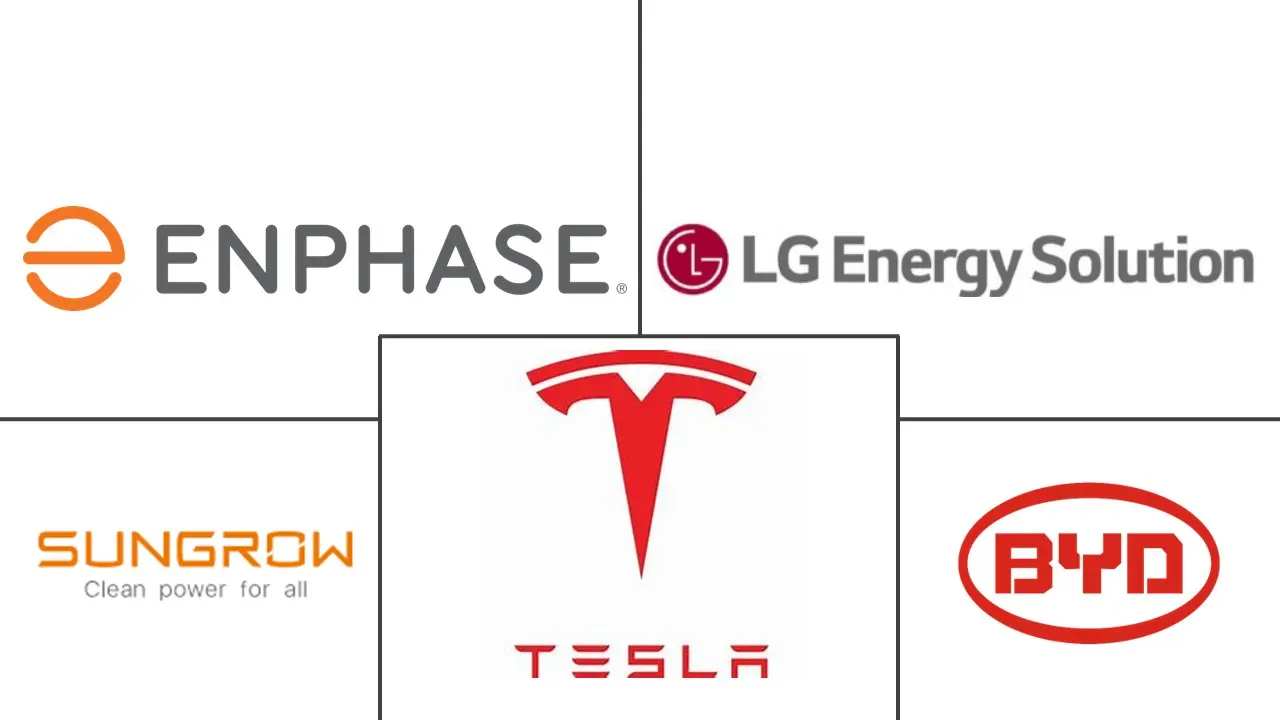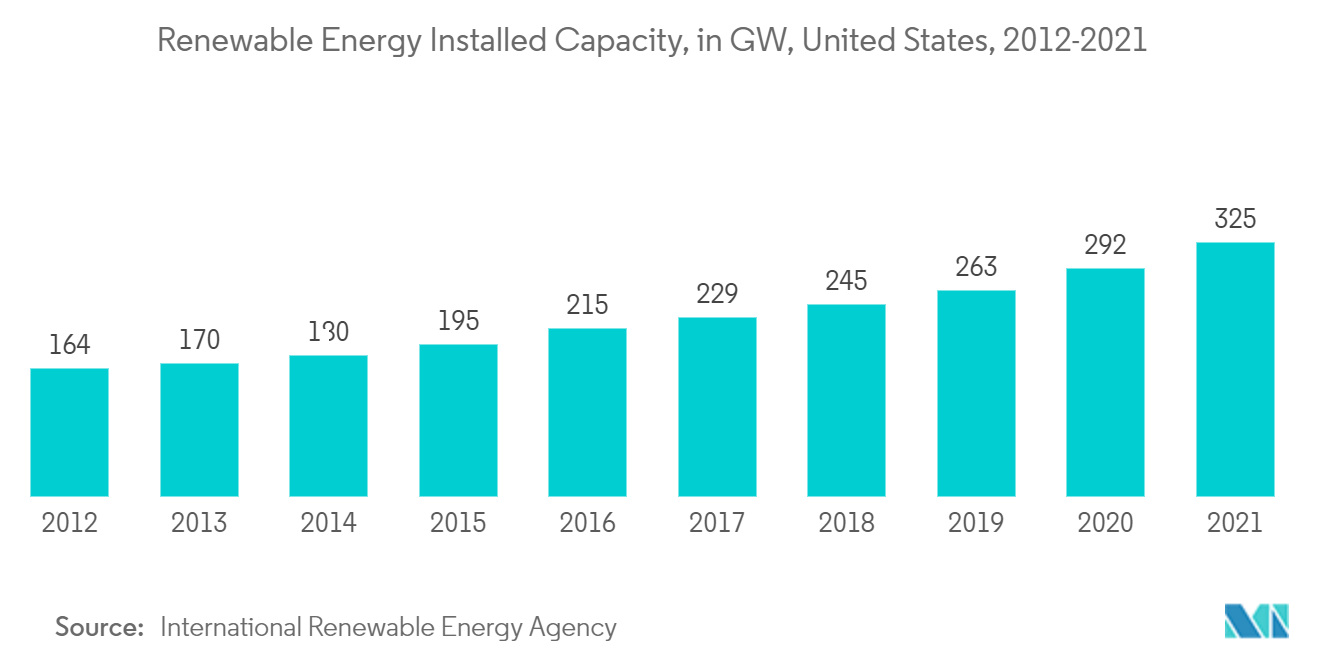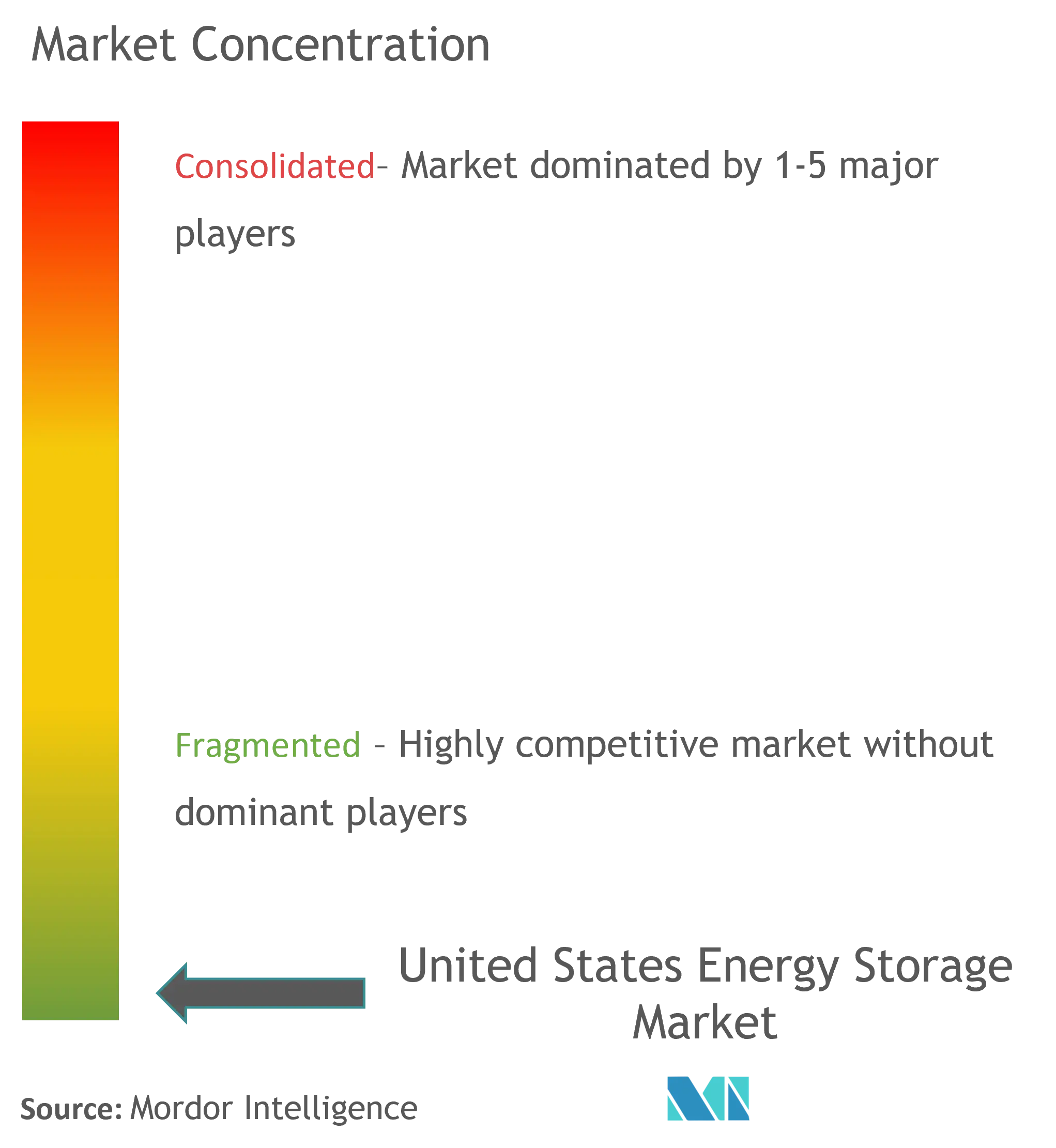US Energy Storage Market Size

| Study Period | 2020 - 2029 |
| Base Year For Estimation | 2023 |
| Forecast Data Period | 2024 - 2029 |
| Historical Data Period | 2020 - 2022 |
| CAGR | 30.00 % |
| Market Concentration | Low |
Major Players
*Disclaimer: Major Players sorted in no particular order |
US Energy Storage Market Analysis
The United States energy storage market is expected to register a CAGR of more that 30% during the forecast period of 2022-2027. Despite the COVID-19 pandemic during 2020, the country witness a significant addition in energy storage capacity. Factors such as increasing installations of renewable energy and decling prices for li-ion batteries are expcted to drive the country's energy storage market during the forecast period. However, scarcity of raw materials used for battery maufacturing is likely to hinder the market growth during the forecast period.
- Residential segment due to increasing renewable energy installations at is expected to dominate the market during the forecast period.
- Researchers in the United States have been at the forefront of researching and developing alternate battery chemistries, which are safer and more efficient than current battery chemistries, thus creating several opportunities fot the market in the future.
- Rising renewable energy generation is expected to be a major driving factor for the United States energy storage market during the forecast period.
US Energy Storage Market Trends
This section covers the major market trends shaping the US Energy Storage Market according to our research experts:
Residential Segment Expected to Dominate the Market
- In the recent past, the energy storage system (ESS) in the United States experienced significant growth, especially in the residential sector, along with the rising investments in renewable energy infrastructure across the regions. Electricity consumption in residential buildings is estimated to increase during the forecast period due to increasing annual disposable incomes and the rising work-from-home trend across the United States. Energy storage systems are used for continuous power supply at homes during power outages at peak hours.
- Various incentive programs across the United States are in place to support the residential energy storage market. California's Self-Generation Incentive Program (SGIP) primarily supports the residential storage sector, and the program offers incentives to new and existing distributed energy resources. Moreover, the residential energy storage segment is likely to proliferate because of increasing technological advancements in energy storage technology, which is leading to a decline in battery prices and widespread deployment of renewable power sources.
- Residential solar installations in New Jersey are likely to witness significant growth on account of favorable incentive programs like Solar Renewable Energy Credits (SREC) and declining cost of solar panels, which was introduced by the government of New Jersey. Shifting trend toward solar to enable the homeowners to save money in electricity bills. Thus, in turn is likely to proliferate the deployment of residential energy storage systems.
- As of June 2021, Q CELLS has partnered with eStat Inc., a clean energy solutions provider in the residential energy sector, to expand its presence in the Hawaiian residential energy market. eStat's cloud-based energy optimization and management technology allow homeowners to build a sustainable Zero Carbon Smart Home that achieves NEM-equivalent savings in Hawaii.
- Therefore, owing to the above points, residential segment is expected to dominate the country's energy storage market during the forecast period.

Rising Renewable Energy Generation Expected to Drive the Market
- Over the last decade, the installed renewable energy capacity and generation has been rising steadily in the United States. As renewable resources such as solar and wind generate power intermittently and at various levels, storing this energy to be used during high demand is of vital importance.
- Due to this, modern energy-storing systems (ESS) are becoming an indispensable part of renewable energy projects. The rapid growth in the renewable energy sector is expected to be one of the strongest drivers for the growth of the ESS market in United States.
- As of 2021, the United States had appoximately 325 GW of renewable intstalled capacity from 160 GW in 2012. The increasing usage of renewable energy has made it easy for energy storage concept to penetrate into the country's market at such a fast rate.
- Traditionally, the most widely-used energy storage technology utilized in the United States has been pumped storage systems. As of 2020, the United States had 22 GW of storage from pumped hydropower and another 1.5 GW in batteries in the residential, commercial, and utility sectors. However, due to their geographical limitations, large land footprint, and falling battery costs, this technology is expected to see limited growth in demand during the forecast period.
- With the development of newer and more affordable lithium-ion batteries, the number of residential, commercial and industrial solar rooftop PV systems coupled with ESS has increased significantly. According to United States Energy Information and Administration (EIA), 71% of the total battery storage capacity in the United States was standalone, while 29% was located at a power generation site in 2020.

US Energy Storage Industry Overview
The United States energy storage market is fragmented. Some of the key players in the market include Tesla Inc, BYD Co. Ltd, LG Energy Solution Ltd, Enphase Energy, and Sungrow Power Supply Co., Ltd.
US Energy Storage Market Leaders
-
Tesla Inc
-
BYD Co. Ltd
-
LG Energy Solution Ltd
-
Enphase Energy
-
Sungrow Power Supply Co., Ltd
*Disclaimer: Major Players sorted in no particular order

US Energy Storage Market News
- In March 2021, Apple inspired the entire corporate world by setting up a solar farm to power its headquarters in California, the United States, and installing rooftop solar panels for its manufacturing park in the city. The company announced that the initiative has been taken by not only one arm, but its 110 manufacturing partners around the globe, which are switching to renewable options to power their infrastructure. It has also implemented a new energy storage project in California to pilot new solutions for renewable infrastructure.
- In November 2021, the energy management company Apparent, California Energy Commission and Los Angeles Department of Transportation entered an agreement for a project to power the electric buses of the city with a solar plus storage microgridsystem. The microgridwill combine 1.5 MW of rooftop and bus canopy-mounted solar PV with a 4.5 MWh battery energy storage system, along with five 1.5 MW electric vehicle (EV) fleet chargers and 104 remote EV charge units. The bus fleet is planned to be electrified by 2028.
US Energy Storage Market Report - Table of Contents
1. INTRODUCTION
- 1.1 Scope of the Study
- 1.2 Market Definition
- 1.3 Study Assumptions
2. RESEARCH METHODOLOGY
3. EXECUTIVE SUMMARY
4. MARKET OVERVIEW
- 4.1 Introduction
- 4.2 Energy Storage Systems Installed Capacity and Forecast in MW, till 2027
- 4.3 Recent Trends and Developments
- 4.4 Government Policies and Regulations
-
4.5 Market Dynamics
- 4.5.1 Drivers
- 4.5.2 Restraints
- 4.6 Supply Chain Analysis
- 4.7 PESTLE Analysis
5. MARKET SEGMENTATION
-
5.1 Technology
- 5.1.1 Batteries
- 5.1.2 Other Energy Storage System Technologies
-
5.2 Phase
- 5.2.1 Single Phase
- 5.2.2 Three Phase
-
5.3 End-User
- 5.3.1 Residential
- 5.3.2 Commercial & Industrial
6. COMPETITIVE LANDSCAPE
- 6.1 Mergers and Acquisitions, Joint Ventures, Collaborations, and Agreements
- 6.2 Strategies Adopted by Leading Players
-
6.3 Company Profiles
- 6.3.1 Tesla Inc
- 6.3.2 Sungrow Power Supply Co., Ltd.
- 6.3.3 BYD Co. Ltd
- 6.3.4 Sonnen GmbH
- 6.3.5 LG Energy Solution Ltd
- 6.3.6 Enphase Energy
- 6.3.7 Voith GmbH & Co. KGaA
- 6.3.8 Andritz AG
- 6.3.9 Siemens Energy AG
- 6.3.10 Fluence Energy
- *List Not Exhaustive
7. MARKET OPPORTUNITIES AND FUTURE TRENDS
** Subject To AvailablityUS Energy Storage Industry Segmentation
The United States energy storage market report includes:
| Technology | Batteries |
| Other Energy Storage System Technologies | |
| Phase | Single Phase |
| Three Phase | |
| End-User | Residential |
| Commercial & Industrial |
US Energy Storage Market Research FAQs
What is the current United States Energy Storage Market size?
The United States Energy Storage Market is projected to register a CAGR of greater than 30% during the forecast period (2024-2029)
Who are the key players in United States Energy Storage Market?
Tesla Inc, BYD Co. Ltd, LG Energy Solution Ltd, Enphase Energy and Sungrow Power Supply Co., Ltd are the major companies operating in the United States Energy Storage Market.
What years does this United States Energy Storage Market cover?
The report covers the United States Energy Storage Market historical market size for years: 2020, 2021, 2022 and 2023. The report also forecasts the United States Energy Storage Market size for years: 2024, 2025, 2026, 2027, 2028 and 2029.
How is the U.S. Energy Storage Market segmented?
The U.S. Energy Storage Market segmented by a) Technology: pumped hydro, electro-chemical, electro-mechanical, and thermal energy storage b) Application: electric time energy shift, electric supply capacity, black start, renewable capacity firming and frequency regulation
US Energy Storage Industry Report
The U.S. energy storage market is poised for significant growth, driven by the demand for modernizing the existing grid network and integrating renewable energy sources. This expansion is bolstered by technological innovations that enhance energy efficiency, favorable regulatory frameworks, and increasing renewable storage capacities. Top battery storage companies and energy storage manufacturers are making substantial investments in pumped hydro storage and electric energy time shift applications.
The residential sector is anticipated to lead, fueled by growing renewable installations and advancements in energy storage technology. Overall, the focus is on boosting grid reliability and resilience, crucial for managing the variability of renewable sources like solar and wind.
For a detailed market forecast and historical overview, refer to industry reports by Mordor Intelligence™, which provide comprehensive market share, size, and revenue growth rate analysis. Download a free report PDF sample for more insights into the U.S. Energy Storage market, including the roles of leading battery storage companies and energy storage manufacturers.
The report covers US Energy Storage Companies and it is segmented by Technology (Batteries and Other Energy Storage System Technologies), Phase (Single Phase and Three Phase), and End-User (Residential and Commercial & Industrial). The U.S. energy storage market is poised for significant growth, driven by the demand for modernizing the existing grid network and integrating renewable energy sources. This expansion is bolstered by technological innovations that enhance energy efficiency, favorable regulatory frameworks, and increasing renewable storage capacities. Top battery storage companies and energy storage manufacturers are making substantial investments in pumped hydro storage and electric energy time shift applications.
The residential sector is anticipated to lead, fueled by growing renewable installations and advancements in energy storage technology. Overall, the focus is on boosting grid reliability and resilience, crucial for managing the variability of renewable sources like solar and wind.
For a detailed market forecast and historical overview, refer to industry reports by Mordor Intelligence™, which provide comprehensive market share, size, and revenue growth rate analysis. Download a free report PDF sample for more insights into the U.S. Energy Storage market, including the roles of leading battery storage companies and energy storage manufacturers.



